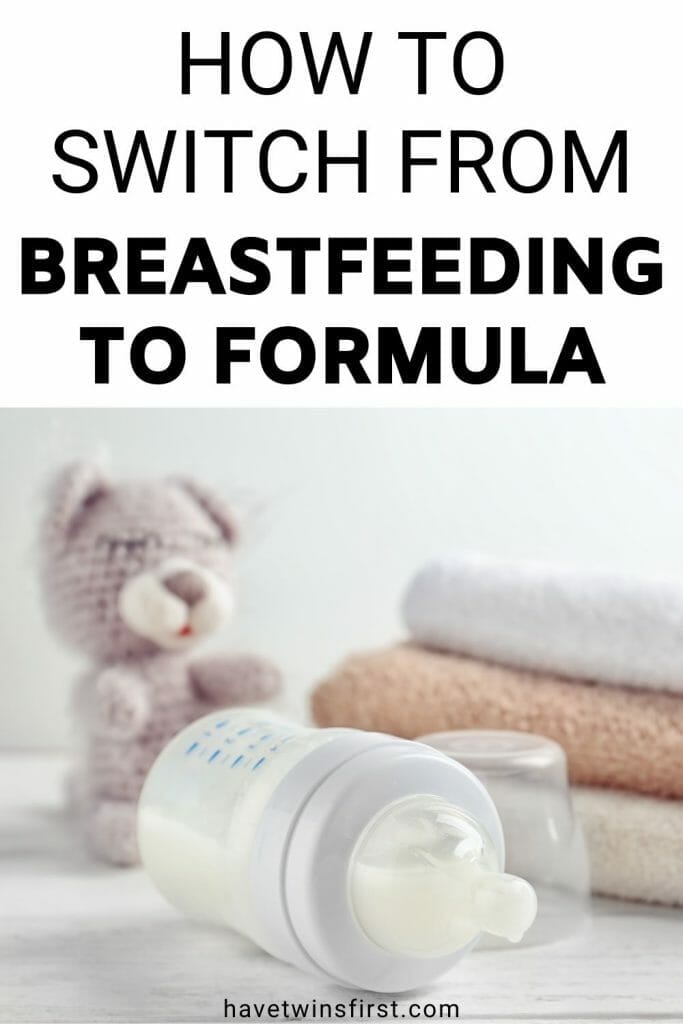Breastfeeding is always advertised as the best way to feed your baby, and rightfully so. But, there might come a time when you want to switch from breastfeeding to formula – and it does not need to be a struggle.
Formula feeding may be something you consider for various reasons including, but not limited to:
- Returning to work
- Your baby needs more than you can physically give
- Breastfeeding is just not working anymore
No matter what the reason, it is possible to switch between the two methods of feeding. This article is going to give you some tips and tricks to make the transition smooth sailing.
Please note, there are affiliate links in this post. Read my privacy & disclosure policy at the bottom of this page to learn more.
Can You Switch From Breastfeeding To Formula?
Yes, you certainly can. But it is not as simple as stopping cold turkey and grabbing a bottle of formula. There are steps to take to ensure the change is stress-free for both you and your little one.
Taking the right steps when you decide to switch from breastfeeding to formula is also the best approach for the overall health of your baby.
When Should I Switch From Breastfeeding To Formula?
Technically there is no “wrong” or “right” time to switch from breastfeeding to formula. However as a rule of thumb, pediatricians and lactation consultants recommend waiting at least 3 weeks before you start supplementing your baby’s feeds with formula (if possible).
The reason for this is to make sure your breastfeeding routine and milk supply are well established before introducing formula.
Reasons To Switch From Breastfeeding To Formula
There are various reasons that you may choose to switch from breastfeeding to formula feeding. And don’t forget, you can also choose to combine breastfeeding and formula feeding.
Here is a list of some of the reasons why formula feeding works for many moms, and it could be just what you need to make an informed choice.
- Sharing the baby feeding responsibility with your partner
- Knowing exactly how much your baby is eating
- Need to take medication that could impact on your baby
- Wine and coffee are no longer off the table
- Baby is struggling to latch
- Breastfeeding is causing you more stress than joy
- You don’t want to or can’t pump at work
- No allocated space to pump
Now that you have some ideas as to why you may want to switch from breastfeeding to formula, let us take a more in depth look at how to make this happen with little to no fuss.
How To Switch From Breastfeeding To Formula
How can you make sure this change from breastfeeding to formula feeding is as stress-free as possible? Here are step-by-step instructions to help you with this transition.
Step 1 – Become Educated
You should educate yourself and get familiar with the various and most popular categories of formula. These include:
- Cow’s milk-based formula
- Soy-based formula
- Hypoallergenic formula
- Specialized formula
Although it is trial and error, there are many options available and it would be best to discuss the exact needs of your baby with your pediatrician.
Step 2 – Find a Time of Stability
Make sure that when you decide to make the breastfeeding to formula switch your family (and especially your baby) is not going through any major disruptions or changes. This could interfere with the task at hand and cause more stress than is necessary.
Disruptions could include teething, sleep regressions, growth spurts, and various other personal things which would not allow you to fully invest time into switching from breastfeeding to formula.
Step 3 – Find the Right Bottle
You will not believe how important this step is. Babies can be extremely fussy when it comes to the bottle they are being fed with.
This will especially be the case if you have been breastfeeding for more than a month as your baby is now used to the shape of your breasts and nipples. Factors to consider when looking for the right bottle:
- Find a bottle your baby likes – you can do this by trying a few different bottles. You can try both a wide neck and a narrow neck bottle, if possible.
- The Babylist bottle box is perfect for this!
- Try various nipple sizes – the flow speed you need will vary depending on your baby’s age.
If you have been pumping breast milk, chances are you have already found a bottle your baby really likes. You can continue using these bottles for formula.
If this is not the case, there are many choices for bottles and you will find what makes your little one happy soon enough.
Step 4 – Put Breast Milk In a Bottle
Getting your baby used to a bottle may be easier if they have a familiar smell or taste – such as breast milk. You don’t want to make your baby quit breast milk cold turkey either. Switching over to formula so dramatically could upset your baby’s stomach.
If your baby has not had a bottle yet, start with just breast milk. If your baby has been bottle fed previously start with about 75% breast milk and 25% formula.
Slowly transition to all formula from there. The next step would be a 50/50 mixture and so on. I recommend spending 1-2 days at each feeding ratio.
Step 5 – Get Other Caregivers Involved
If your baby has never had a bottle before, it’s important that someone other than the nursing mom try to give the bottle at first. Get your partner involved or another family member and make sure you leave the room or the house all together when the bottle feeding happens.
This way your baby will not be associating the person giving the bottle with nursing and may be more likely to accept the bottle.
Step 6 – Paced Bottle Feeding
Pacing the bottle feed means you let your baby drink small doses and avoid him gulping down formula. If babies drink too much at once it can become extremely uncomfortable for them and they will fill up way too fast.
To pace bottle feed, let your baby drink a small amount. Once he stops sucking, tilt the bottle up so that there is no milk flow. Give your baby a break and let him breathe before offering more milk.
Step 7 – Slowly Drop Nursing Sessions
Instead of just quitting breastfeeding all at once, it is much better and safer to wean from breastfeeding. Start by dropping just one breastfeeding session and replace it with a formula feed.
Assuming the formula feed is going well, every few days drop another breastfeeding session and replace it with feeding formula. Keep doing this until all feeds are with formula.
Step 8 – Consider Partial Weaning
Keep in mind, that this transition does not have to be an all-or-nothing situation. It may be beneficial to only partially wean and feed your baby with a combined diet of breast milk and formula.
This could be something along the lines of, breast milk during the day and only formula at night. Or, formula while you are at work and nursing when you are home with your baby.
The most important thing is to do what works for you and your baby. Don’t be hard on yourself if it takes a while to find a happy medium, that is fine too.
Remember that you may not get it right immediately and you might face some resistance from your baby, but perseverance will pay off in the end.

When & How To Introduce a Bottle To a Breastfed Baby
When should you introduce a bottle to your breastfed baby? And how do you do it?
A good rule of thumb is to introduce a bottle once a healthy milk supply has been established, which is right around 4 weeks. Additionally, you don’t want to wait until your baby is too old to introduce a bottle.
If you wait too long your baby might give you difficulty with accepting bottles. Therefore, we recommend introducing a bottle between 4 weeks and 8 weeks.
Best Formula To Switch To From Breastfeeding
One concern you will have when making the switch from breastfeeding to formula feeding is which formula is best for your baby. There are so many on the market!
The following list contains the formulas which are often recommended by physicians AND are great for babies switching over from drinking breast milk.
Similac Pro-Advance
This Similac formula contains human milk oligosaccharides, which are a prebiotic also found in breast milk. It also provides a range of nutrients including lutein, which may aid eye development, and an Omega-3 called docosahexaenoic acid (DHA).
One of the main reasons many physicians will recommend the Similac Pro-Advance formula is because it contains no GMOs.
Enfamil Enspire
If you are looking for a formula which is as close to breast milk as possible, Enfamil Enspire is the best option.
Enfamil Enspire has MFGM and Lactoferrin, two key components found in breast milk. This makes it one of the healthiest choices when it comes to infant formula.
Happy Baby Organics Formula
Happy Baby Organics Formula is organic and contains ingredients that are nourishing and healthy for your baby. What makes Happy Baby Formula a good choice?
It has various stages so you can buy the one that meets baby’s growing needs.
Formula Prep & Feeding Tips
Now that you have chosen the formula you will be feeding your baby, how do you prepare it? The best advice is to follow the instructions on the packaging and do not alter from that.
When you mix the formula swirl it rather than shake it to prevent bubbles from forming that your baby then ingests.
Combining Breastfeeding & Formula Feeding
Can you combine breastfeeding and formula feeding? Absolutely yes, as has been alluded to and discussed above as well.
The best way to do this is to choose a specific time in the day to breastfeed and then a different time to formula feed. It’s common to go with formula feeding at night because your partner can help with the feeds. Formula also fills a baby’s stomach just a little bit more so he might sleep longer.
How To Wean From Breastfeeding
Weaning from breastfeeding is a process, and the best way to do this is slowly. Drop one feed at a time and replace it with formula. Wait a few days before dropping another feed.
Even if it takes a week or more to have your baby fully on formula, it will eventually work out. If your baby struggles with the transition, you can also add some formula to your breast milk bottles.
When you decide to switch from breastfeeding to formula – remember slow and steady wins the race, don’t do it cold turkey!
Some of the key tips and tricks that can help you through this transition include transitioning to formula slowly and finding the right bottle and bottle nipple for your baby. Discuss any concerns with the pediatrician or a lactation consultant.
Finally, do not be too hard on yourself if your baby refuses the bottle the first few times, it is a trial and error process. Even finding the right formula might not happen overnight. But when it does, it will be well worth the journey.








